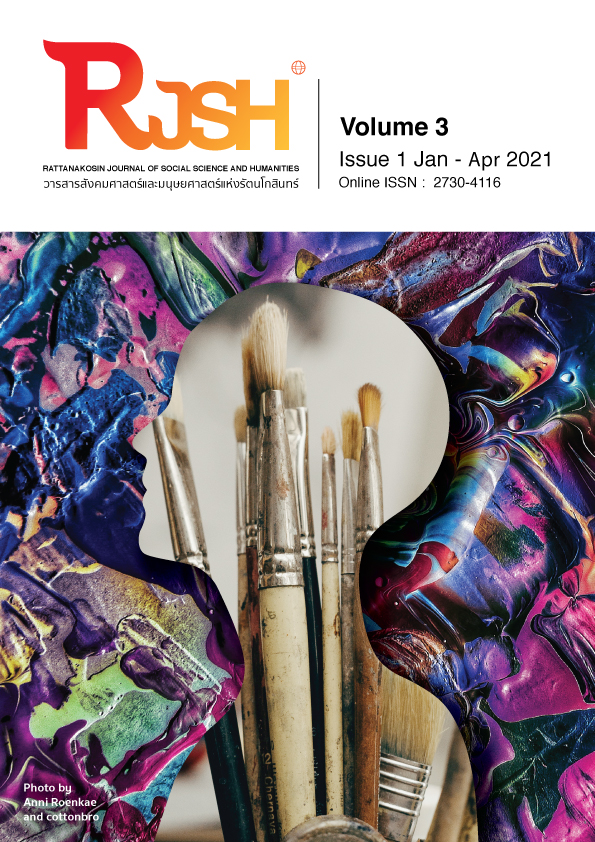Sound Changes of Hainanese in Thailand from Proto to Present Time
Main Article Content
Abstract
The study aimed to study Hainanese sound change in Thailand from Proto sound to the Present time. Data were analyzed by the comparative method from previous studies of phonological of Hainanese in Thailand. The result showed in three parts. First, Proto Hainanese Tones had three tones: píng, shɑ̌ng, and qù. The tonogenesis of Hainanese in Thailand was a two-way split based on voicing. Second, Proto Hainanese Consonants had 28 consonants: 11 voiceless initial consonants and seventeen voiced initial consonants had become 18 consonants in Hainanese. The consonant sound change of Hainanese was voiceless became voiced, strengthening, weakening, devoicing, and palatalized. Finally, Proto Hainanese Vowels had two types: Proto monophthongs: six oral and two nasalized vowels and Proto diphthong vowels: six oral vowels and two nasalized vowels had become five oral monophthongs and three oral diphthong vowels in Hainanese, respectively. Moreover, this study found that some Hainanese people in Thailand use some Teochew words instead of their Hainanese words.
Keywords: Hainanese, sound change, Proto sound, Chinese dialect
Article Details
The content within the published articles, including images and tables, is copyrighted by Rajamangala University of Technology Rattanakosin. Any use of the article's content, text, ideas, images, or tables for commercial purposes in various formats requires permission from the journal's editorial board.
Rajamangala University of Technology Rattanakosin permits the use and dissemination of article files under the condition that proper attribution to the journal is provided and the content is not used for commercial purposes.
The opinions and views expressed in the articles are solely those of the respective authors and are not associated with Rajamangala University of Technology Rattanakosin or other faculty members in the university. The authors bear full responsibility for the content of their articles, including any errors, and are responsible for the content and editorial review. The editorial board is not responsible for the content or views expressed in the articles.
References
Baxter, W.H. (1996). Trends in Linguistics Studies and Monographs 64: A handbook of Old Chinese Phonology. Berlin: NewYork.
Benedict, P.K. (1972). Sino-Tibeton: a conspectus. (Princeton-Cambridge studies in Chinese linguistics 2), with contributing editor James A. Matisoff, NewYork, Cambridge University Press.
Guillaume, J. (2006). Introduction to Chinese Historical Phonology. Université Paris V René Descartes – CRLAO.
Janida, E. (2004). The Phonological Interference of Swatow in Standard Thai by Chinese Speakers in Bangkok. Bangkok: M.A. thesis in Linguistics. Faculty of Graduate Studies, Mahidol University.
Norman, J. (1988). Chinese. Cambridge: Cambridge University Press.
Norman, J. (1991) . The Min Dialects in Historical Perspective. In Languages and Diealects of China. [Journal of Chinese Linguistic Monograph Series No.3.] Edited by William S-Y. Wang. Berkeley: University of California. Pp.325-360.
Yuán, jiāhuá (1989). Hànyǔ fāngyán gàiyào [An introduction to Chinese dialects]. Beijing, China: Wénzì găigé chǔbănshè. (袁家驊. 1989. 漢語方言概要. 北京:文字改革出版社.)
Yuán, Jiāhuá et al. (1960) Hànyǔ Fāngyán Gàiyào [An Outline of the Chinese Dialects]. Beijing: Wenzi Gaige Chubanshe. (2nd edition, 1989).
Wichet Atchariyasucha. (1982). A phonological study of Swatow of Chinese as spoken in Bangkok with comparisons to Thai. Bangkok: M.A. thesis in Linguistics. Faculty of Graduate Studies, Mahidol University.
Zirivarnphicha Thanajirawat. (2010). The Phonological Characteristics of Chinese Dialects in Thailand. Institute for Language and Cultures of Asia: Mahidol University.

